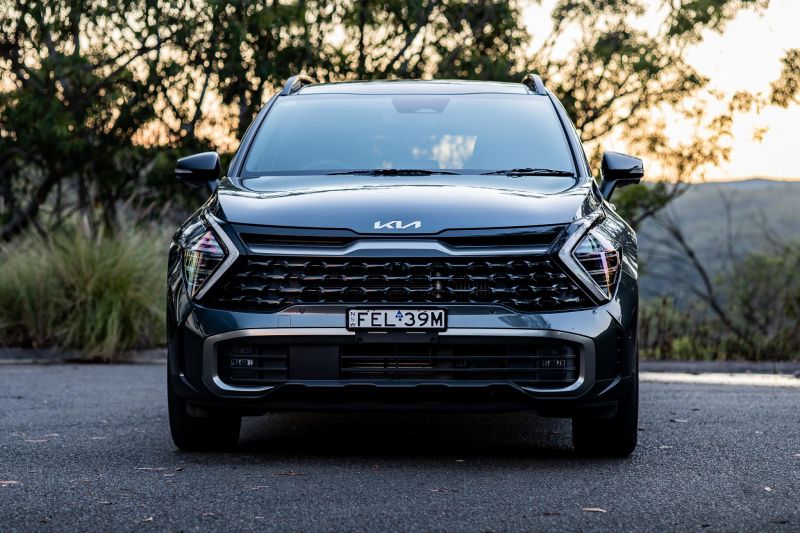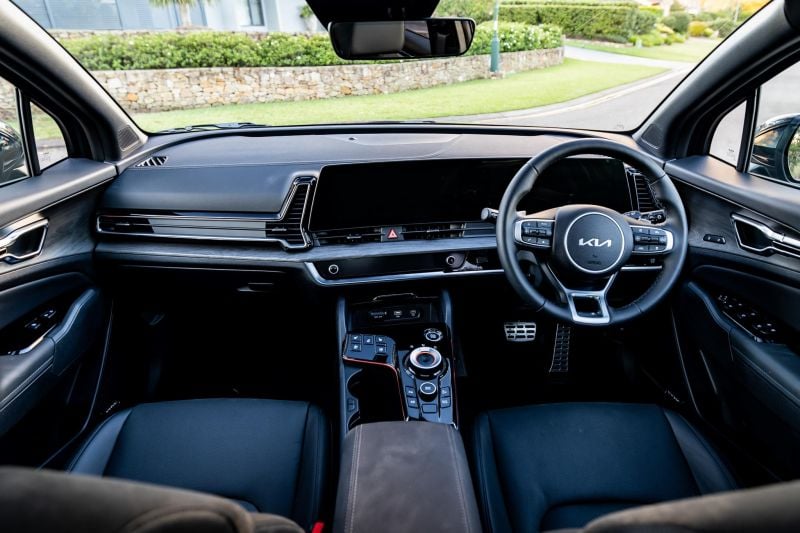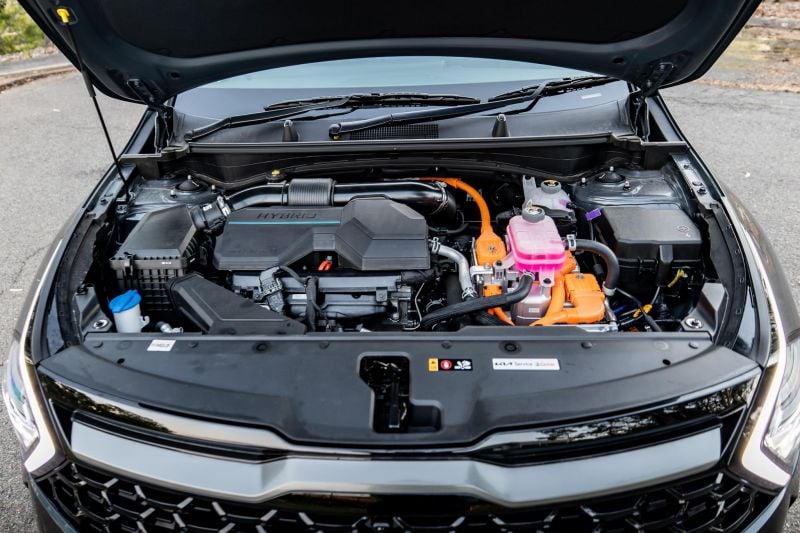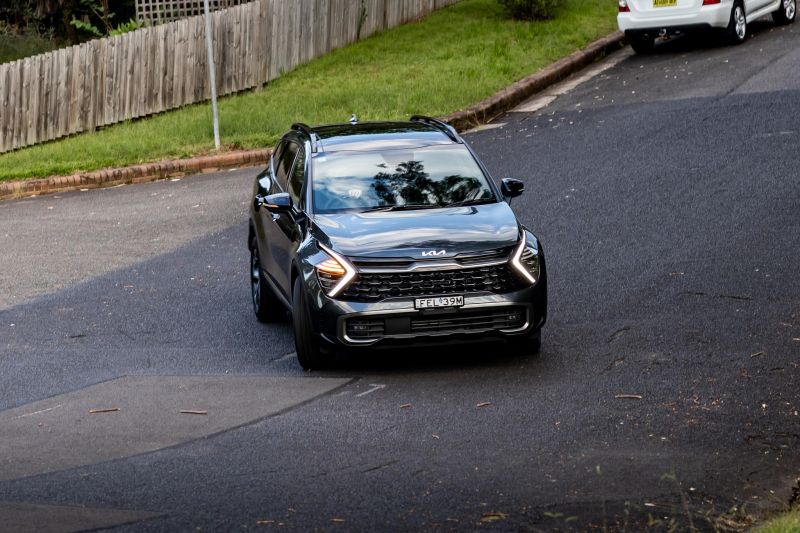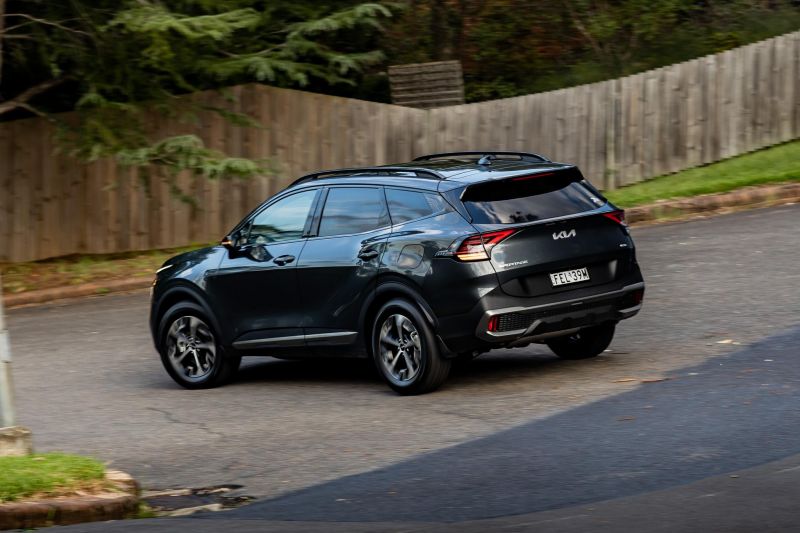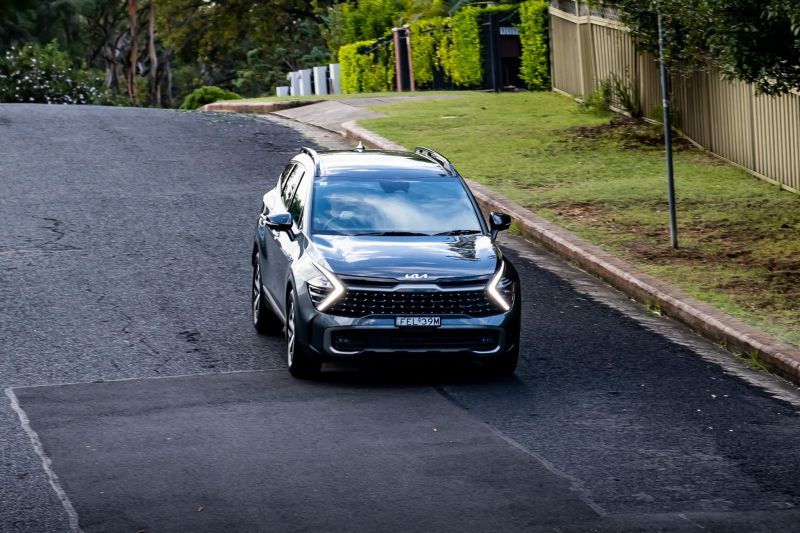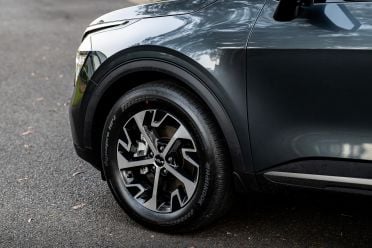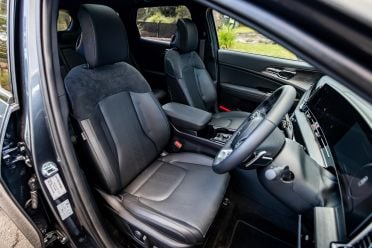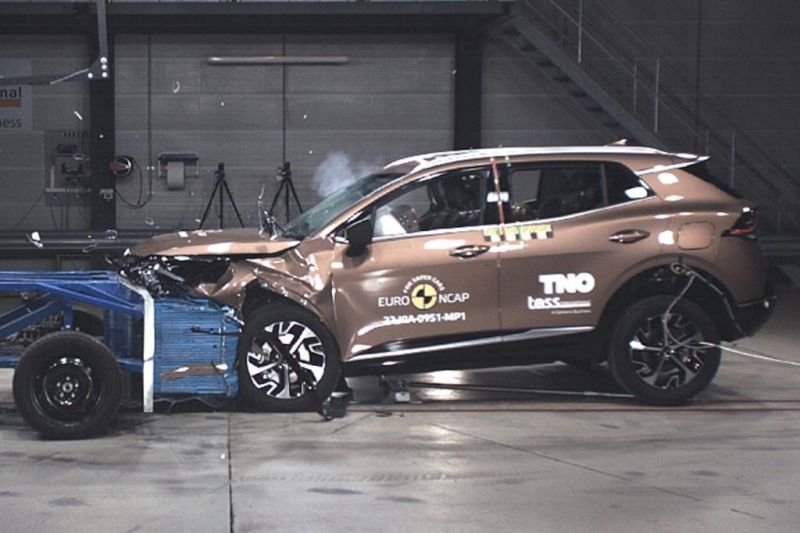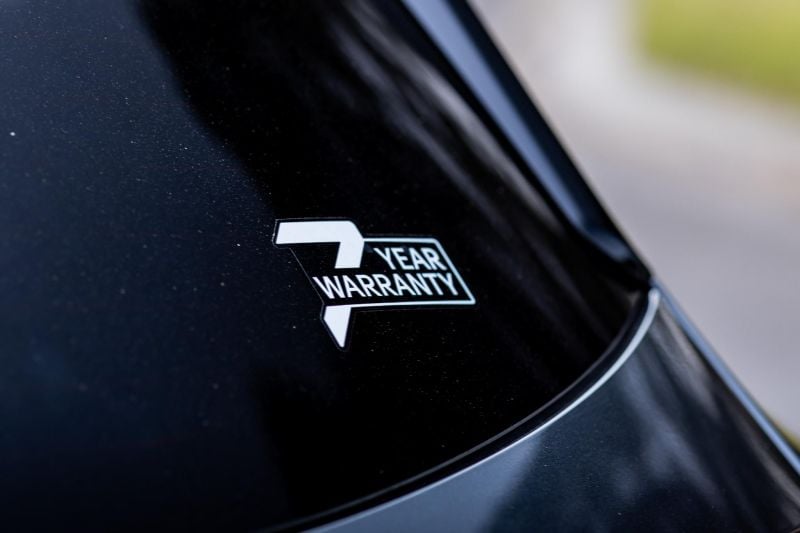The Kia Sportage range finally has a hybrid option to go up against the Toyota RAV4.
Note: This is an updated version of a review that was first published in April 2024. There have been no major changes to pricing or specification since then.
A mid-life update is due to launch in the second quarter of 2025, though pricing and specifications are still to be announced and we have not driven the new model as yet.
We have updated key details with the most up-to-date information available. Read the original version of this review here.
WATCH: Paul’s video review of the 2024 Kia Sportage SX Hybrid
In fact, there are two petrol-electric hybrid (HEV) models to choose from – the SX, and this one, the GT-Line, which is the sportier looking and more richly specified model of the two.
It has an intriguing turbo-petrol-hybrid setup, but only comes with front-wheel drive – and the price premium is questionable as a result. So should you consider it? Read on to find out.
How does the Kia Sportage compare?
View a detailed breakdown of the Kia Sportage against similarly sized vehicles.

Kia
Sportage
How much does the Kia Sportage cost?
At a glance, the Sportage GT-Line Hybrid seems a bit pricey.
| Model | Price before on-road costs |
|---|---|
| S | |
| Kia Sportage S 2.0 FWD 6MT | $32,995 |
| Kia Sportage S 2.0 FWD 6AT | $34,995 |
| Kia Sportage S 2.0D AWD 8AT | $40,395 |
| SX | |
| Kia Sportage SX 2.0 FWD 6MT | $35,550 |
| Kia Sportage SX 2.0 FWD 6AT | $37,550 |
| Kia Sportage SX 2.0D AWD 8AT | $42,950 |
| Kia Sportage SX 1.6T HEV FWD 6AT | $45,950 |
| SX+ | |
| Kia Sportage SX+ 2.0 FWD 6AT | $42,950 |
| Kia Sportage SX+ 1.6T AWD 7DCT | $44,050 |
| Kia Sportage SX+ 2.0D AWD 8AT | $47,450 |
| GT-Line | |
| Kia Sportage GT-Line 1.6T AWD 7DCT | $49,920 |
| Kia Sportage GT-Line 2.0D AWD 8AT | $52,920 |
| Kia Sportage GT-Line 1.6T HEV FWD 6AT | $55,420 |
You know, $55,420 before on-roads is more than you’d pay for a high-grade RAV4 Cruiser 2WD Hybrid ($51,410), and more than an all-wheel-drive Forester Hybrid S ($50,140).
But it is slightly more palatable than the Honda CR-V e:HEV RS ($59,900 drive-away), and that SUV is also only available in FWD. However, you will be paying a similar price, on the road, for this Kia.
So, you’re paying a whack more than the all-wheel-drive GT-Line models, but you’re getting less. Well, you get front-wheel drive, and you get a lower fuel consumption figure and much better emissions figures, too.
Kia Australia has indicated we can expect cheaper hybrid models to join the lineup with the Sportage’s forthcoming mid-life update, with AWD to also join the range.
To see how the Sportage lines up against its rivals, check out our comparison tool
What is the Kia Sportage like on the inside?
This is the most premium version available for the Kia Sportage, and it does have a high-end look and feel to the cabin.
I particularly like the twin-screen display set up – two 12.3-inch units in a curved housing – which looks terrific, and thankfully is also really simple to use. The touchscreen media system sits alongside a bright and colourful info-rich display for the driver.
The latter also doubles as a display for a Blind-Spot View Monitor in this spec, so when you indicate you will be able to see what is potentially in your blind spot. There’s also other information on that driver’s screen, including things like your digital speedometer, fuel use, and plenty more.
The infotainment screen has Apple CarPlay and Android Auto, though it is strictly by cable connection which is a little bit disappointing – I would prefer wireless every time. There is also a wireless phone charger, USB-A and USB-C ports, and a 12-volt.
The usability of the touchscreen is very good, and you will easily get used to the menu layout and structure of the controls on screen. Thankfully there is another row of controls down below as part of a switchable panel.
That control panel covers your climate settings, including fan speed adjustment and dials for temperature adjustment, but if you flick a switch towards the left of the panel you turn it into a media control station as well, with a bunch of menus for sat nav, radio and setup menus all available there. Also when you hit that switch, the climate control knobs turn into volume and tuning knobs.
Storage is good throughout the cabin. With a pair of retractable cup holders you can turn the area near the shifter into a flat storage zone if you prefer. Ahead of the gear selector there’s a wireless phone charger with a cover, and in each of the doors there are bottle holders, plus there’s a covered centre console bin between the front seats.
I’m not a huge fan of all the piano black finishing in the centre console area, but at least there are buttons for your seat heating and cooling, and for the GT-Line Hybrid you also get a heated steering wheel. There’s also a rotary dial for drive modes, with Eco, Sport and Smart modes available – each of which change the display on the driver’s cluster.
I like the fact you’ve got a button on the steering wheel to turn off the lane-keeping system and this product thankfully doesn’t have the annoying speed limit beep technology that many other new Hyundai-Kia vehicles do – to me that’s a huge plus.
Seat comfort is decent and you have adjustable lumbar support. Some people might find the seats just a little bit flat however.
At 182cm/6’0” tall, and with the driver’s seat set for my position, there is ample room for me in the second row to comfortably slouch, and easily enough room for three people across the back. If you have children, there are ISOFIX points in the window seats, and three top-tethers.
Everyone in the back is well catered for, with directional air-vents, map pockets on the seat backs, as well as a hard kick plate on the back of each of the front seats. On those seat backs you’ll also find USB-C charging ports and shopping/school bag hooks.
There are bottle holders in the doors and a flip-down armrest with cupholders, plus another small storage section below the air-vents, where you might store a phone that’s on charge.
There is a slight transmission tunnel intrusion in the back, but it’s not a massive issue for space. There’s also a section on top of the seat backs where you might hang a jacket, or maybe even wedge an iPad in.
Boot space is good. There’s 586 litres of cargo capacity with the back seats up, and the cargo area includes an LED light, quick release levers to drop the seats (1872L seats down), a 12V port, as well as attachment points for a cargo net which can be stored under the boot floor, alongside the cargo cover.
There’s also a space-saver spare wheel, and while there are shopping bag hooks, they’re right at the back of the boot and not that well positioned.
To see how the Sportage lines up against its rivals, check out our comparison tool
What’s under the bonnet?
Choose the hybrid version of the Kia Sportage and you get a 1.6-litre turbocharged four-cylinder engine producing 132kW of power and 265Nm of torque, teamed with a 44kW/264Nm electric motor, and a 1.49kWh lithium-ion battery.
Total system outputs are 169kW and 350Nm, which is plenty for this type of application.
However, that much grunt is enough to overwhelm the front tyres at times. That’s right, the hybrid Sportage only comes with front-wheel drive in Australia, and that could be a deal-breaker for some.
Unlike other hybrid models from the Hyundai-Kia group which run a dual-clutch auto, there’s a standard six-speed automatic transmission fitted to the Sportage.
When it comes to the official combined cycle fuel efficiency figure, Sportage HEV models claim 4.9 litres per 100km on the combined cycle which for those playing along at home is 0.1 litres per 100km more than a RAV4 2WD Hybrid.
In reality, over days of the sort of driving that you’ll probably do in a Sportage Hybrid – urban running, commuting, freeway stints, daycare drop-offs and even a couple of IKEA runs – I saw a return of 6.0 litres per 100km. Coincidentally that’s what I saw last time I drove a RAV4 Hybrid!
Now, for those conscious of emissions, the HEV model stacks up well. The Hybrid’s official combined cycle number is 110g/km of CO2, whereas the diesel is 163g/km, and the turbo-petrol is 164g/km CO2. For eco-conscious customers or fleet buyers, that could get the petrol-electric version across the line.
Don’t go thinking that it can’t tow, either. It has a 750kg unbraked trailer rating, and 1650kg braked trailer rating – but keep in mind that the maximum tow bar down weight is 100kg.
To see how the Sportage lines up against its rivals, check out our comparison tool
How does the Kia Sportage drive?
It’s a bit of a novel approach to hybrid tech, this powertrain.
Not quite as novel as the Nissan e-Power setup, and perhaps not as conventional as the Toyota hybrid system, but instead you do get a hybrid powertrain that is both refined, powerful, and efficient and equal measure.
The turbo engine element to this petrol-electric system means that you do have a little bit of extra urgency when you need it, and that is most noticeable in Sport mode if you ever choose to drive in that setting.
The engine’s low-rev push and the electric motor work together in conjunction with the conventional six-speed automatic transmission to make for a pretty enjoyable driving experience in terms of the powertrain.
It’s quieter than a RAV4, and it feels a bit more potent than one too. It is also different in that the electric motor is integrated into the transmission, so you can feel the car change gears in EV mode, which is cool.
It has a nice transition between EV and conventional driving modes and in my testing it used the EV mode pretty regularly, including on the freeway in stints, and plenty of urban driving. There’s a pedestrian warning system with an external speaker to warn others of your presence, as otherwise it’s pretty silent.
However, the big downside with this hybrid powertrain is it is strictly front-wheel-drive, and that means that you will at times struggle to get all of the torque to the ground smoothly and effectively.
A number of times during my drive in the GT-Line Hybrid I found the front tyres scrambling for traction, even under what I thought was pretty moderate acceleration. If you’re a leadfoot, you might find that it’ll screech a fair bit.
The other elements of the drive experience are typical of what we’ve come to expect of the Sportage, and that is to say it’s good in most ways.
The ride is comfortable, although it can still feel a little clunky over broken surfaces. Thankfully you don’t have 19-inch wheels with even lower-profile tyres to exacerbate that mannerism.
The steering is accurate and adequate for this application. There’s a decent amount of heft at higher speeds, and lightness at low speeds which helps with parking moves (as does the surround-view camera system).
I typically turn off the lane-keeping assistance feature on the freeway or around town as I find it can be just a little bit too pushy for my liking.
The braking response and the pedal feel is good too. Being an electrified car, it does have a regenerative braking system and typically that can lead to less-than-ideal brake pedal feel. But thankfully in the Sportage it’s honest and it pulls up pretty well.
It’s also pretty quiet – there’s not a whole lot of engine noise intrusion at higher speeds, and even road noise is kept to a minimum on rougher surfaces.
If only it had all wheel drive, this could be a RAV4 killer.
To see how the Sportage lines up against its rivals, check out our comparison tool
What do you get?
The Sportage HEV is available in SX and GT-Line trim levels, and specifications largely mirror the existing petrol and diesel equivalents.
Sportage SX HEV highlights:
- 18-inch alloy wheels
- Auto LED reflector-type headlights
- Auto high-beam
- Rain-sensing wipers
- Power-folding exterior mirrors
- 12.3-inch touchscreen infotainment system
- Wired Apple CarPlay, Android Auto
- Satellite navigation
- ‘Basic’ digital instrument cluster with 4.2-inch screen
- 6-speaker audio
- Cloth upholstery
- Leather-appointed steering wheel
- Dual-zone climate control
- Electronic parking brake with auto hold
- Space-saver spare wheel
- Dial-type shift-by-wire selector
Sportage GT-Line HEV adds:
- LED projector-type headlights
- Full LED tail-lights
- Leather upholstery
- Keyless entry, start
- Electrochromic rear-view mirror
- Hands-free power tailgate
- Wireless phone charger
- 64-colour ambient lighting
- 8-speaker Harman Kardon premium audio
- 12.3-inch digital instrument cluster
- 8-way power driver’s seat, 2-way power lumbar
- 8-way power passenger seat
- Heated, ventilated front seats
- Heated steering wheel
- Panoramic sunroof
- Rear privacy glass
- Alloy sports pedals
To see how the Sportage lines up against its rivals, check out our comparison tool
Is the Kia Sportage safe?
As with the petrol and diesel models in the range, HEV versions of the Sportage come with the maximum five-star ANCAP safety rating based on 2022 testing.
| Category | Kia Sportage |
|---|---|
| Adult occupant protection | 87 per cent |
| Child occupant protection | 87 per cent |
| Vulnerable road user protection | 66 per cent |
| Safety assist | 74 per cent |
Standard safety equipment includes:
- Autonomous emergency braking
- Vehicle, pedestrian and cyclist detection
- Junction assist
- Blind-spot assist
- Rear cross-traffic assist
- Driver attention alert
- Intelligent speed limit assist
- Lane keep assist
- Lane Following Assist (lane centring)
- Safe exit warning
- Front, rear parking sensors
- Reversing camera
- Tyre pressure monitoring
- Front, front-side and curtain airbags
- Front centre airbag
Sportage GT-Line adds:
- Blind Spot View Monitor
- Surround-view camera
- Parking Collision Avoidance Assist – Reverse
To see how the Sportage lines up against its rivals, check out our comparison tool
How much does the Kia Sportage cost to run?
Kia covers its lineup with a seven-year, unlimited-kilometre new car warranty. For electrified products like the Sportage HEV, high-voltage components like the on-board charger, electric motor and battery system are covered for seven years or 150,000 kilometres – whichever comes first.
| Running costs | Kia Sportage Hybrid |
|---|---|
| Warranty | 7 years, unlimited kilometres – vehicle 7 years or 150,000 kilometres – HEV components |
| Roadside assistance | Up to 8 years |
| Service intervals | 12 months or 10,000km |
| Capped-price servicing | 7 years or 70,000km |
| Total capped-price service cost | $4502 |
| Average capped-price service cost | $643 |
It appears the Sportage HEV is the priciest engine variant to service, and Kia continues to charge above average amounts for capped-price servicing.
For reference, Hyundai offers a five-year pre-paid service plan for the Tucson Hybrid for $1990 – nearly $1000 less than what Kia charges over the same period for the Sportage HEV.
To see how the Sportage lines up against its rivals, check out our comparison tool
CarExpert’s Take on the Kia Sportage
It’s so close to being the hybrid SUV we’ve been hoping for, but a lack of all-wheel drive, frankly silly servicing costs and short intervals make it less compelling than it could have otherwise been.
Even so, this is a great family SUV for those who can deal with front-wheel drive and don’t mind paying a little more for their maintenance. If that’s you, I’d definitely recommend you go and check it out.
Hopefully, the incoming updated addresses our key complaints.
Interested in buying a Kia Sportage? Get in touch with one of CarExpert’s trusted dealers here
Click the images for the full gallery
MORE: Everything Kia Sportage



